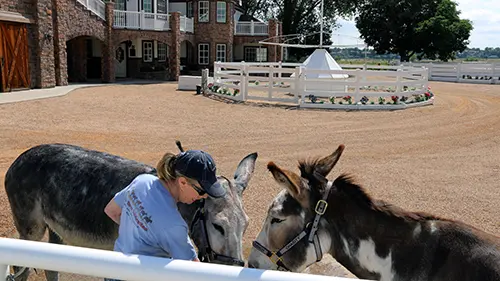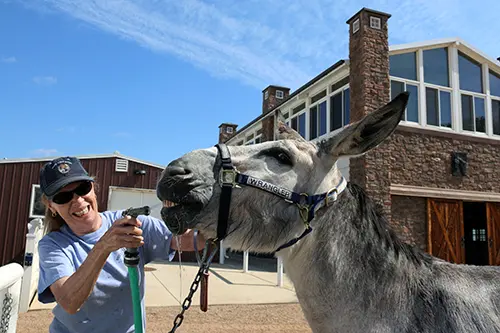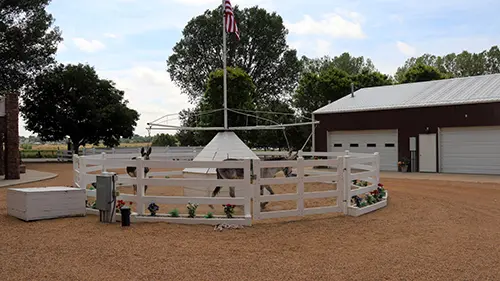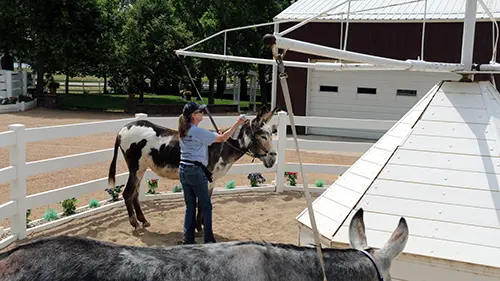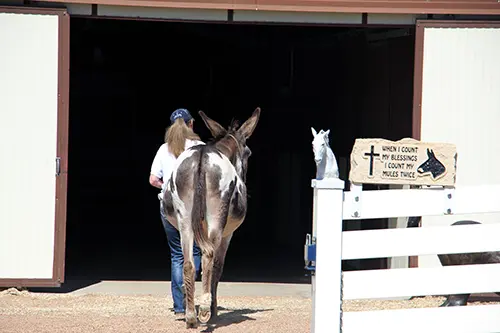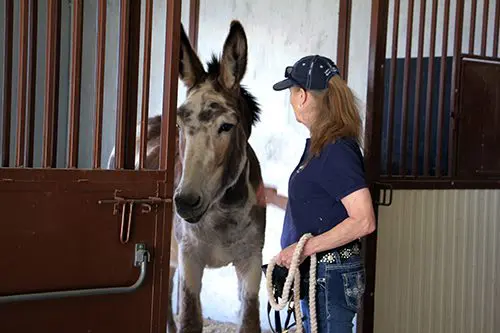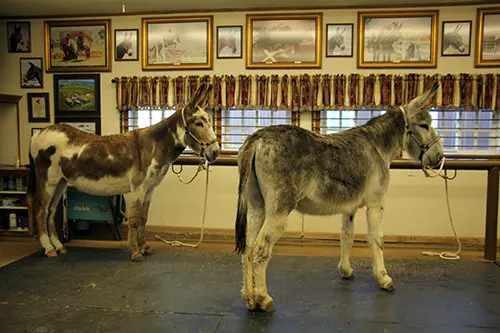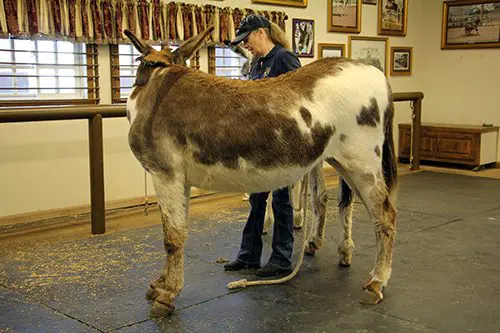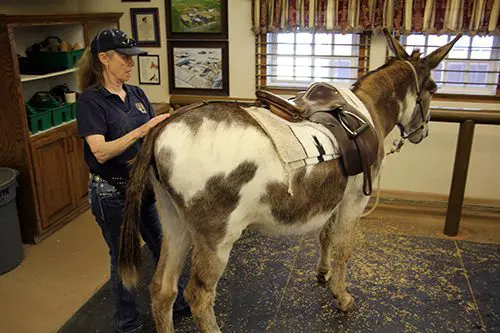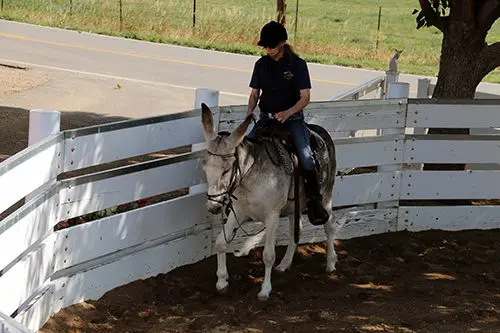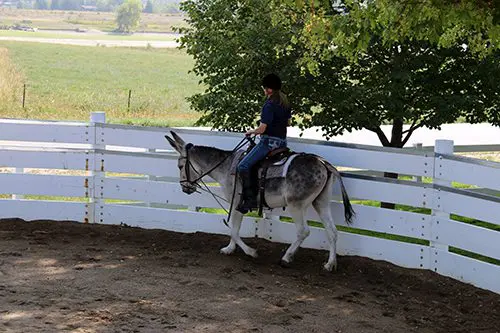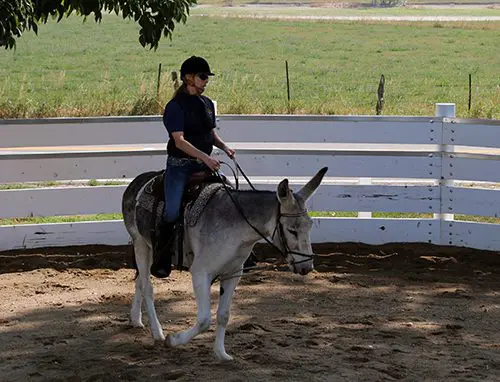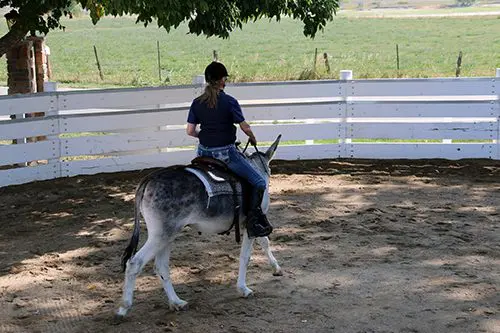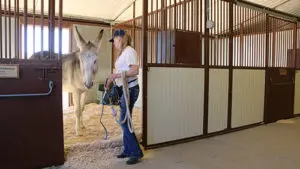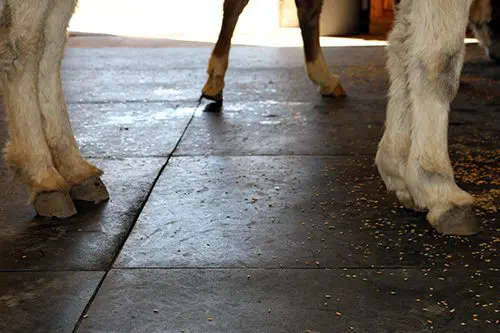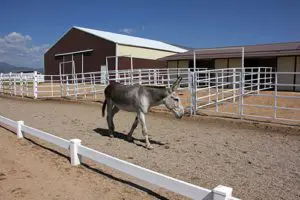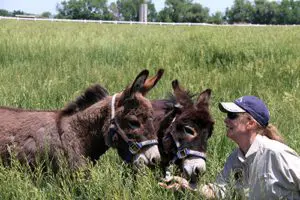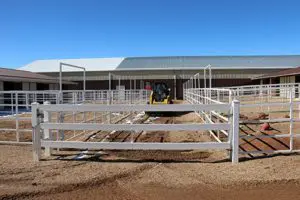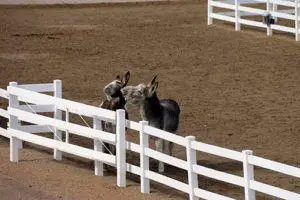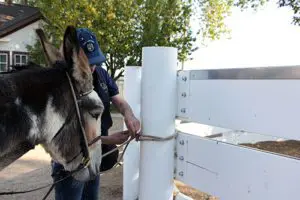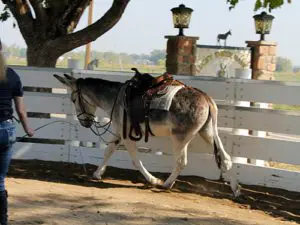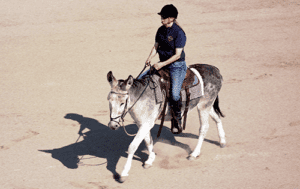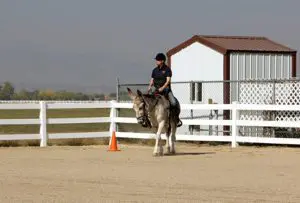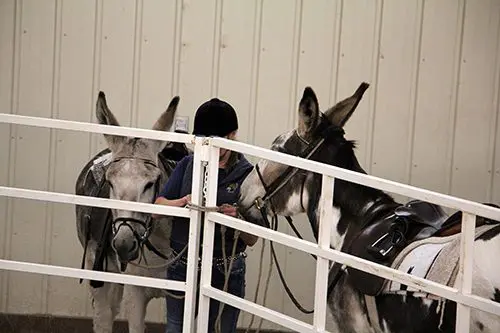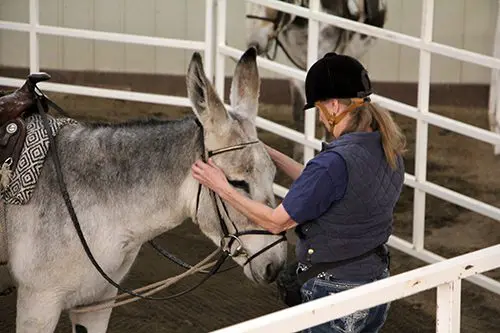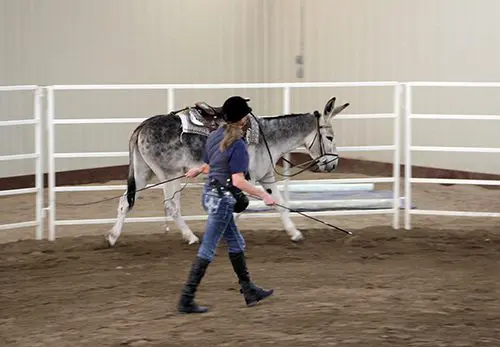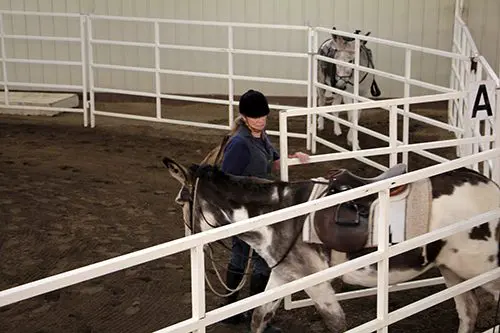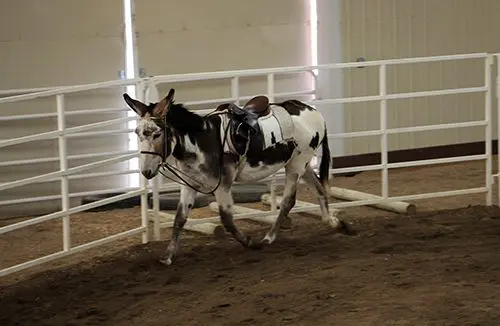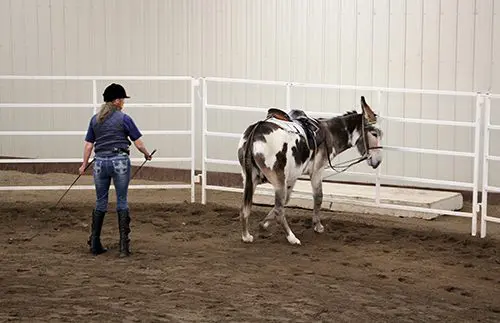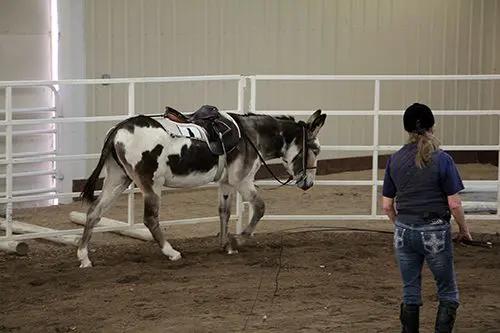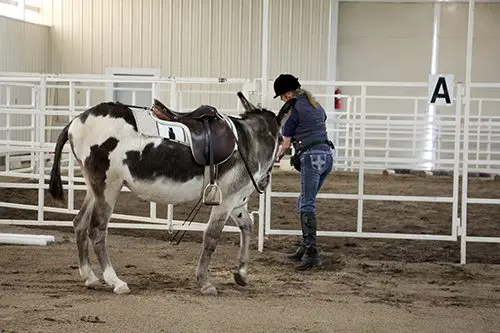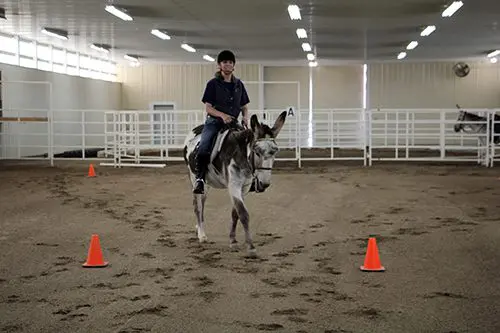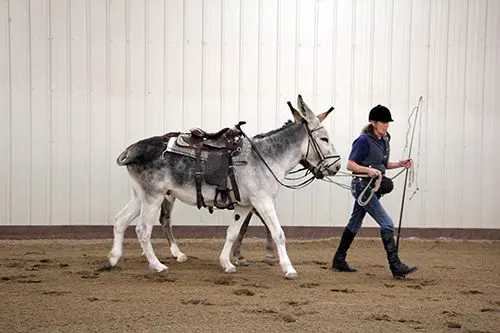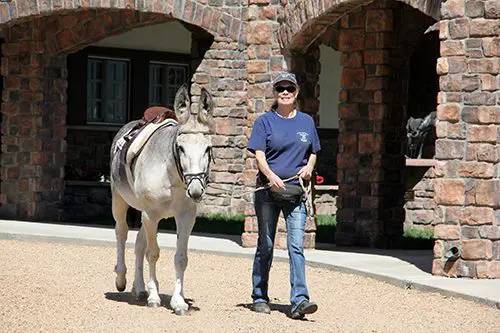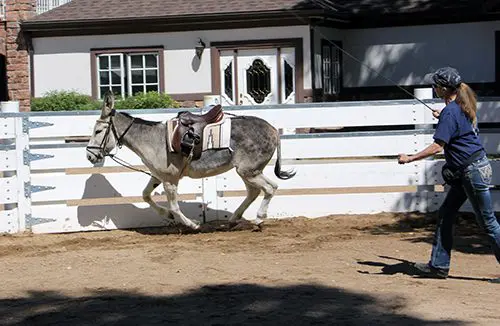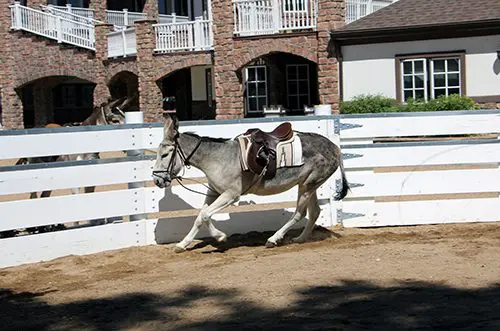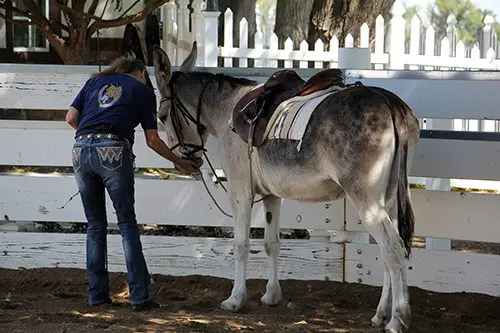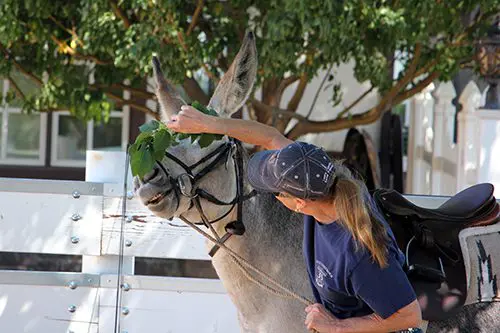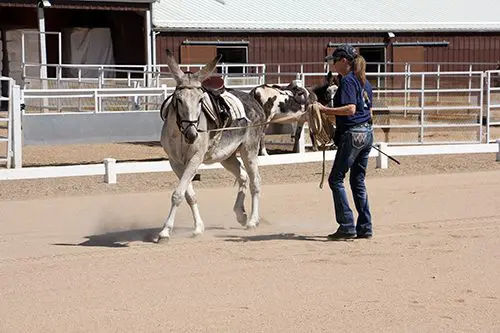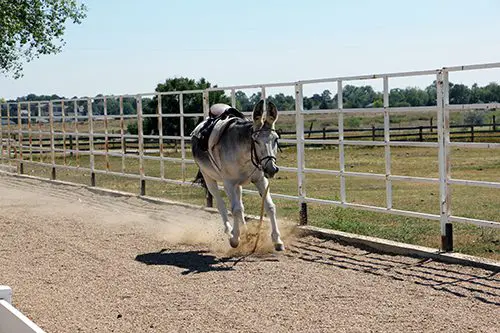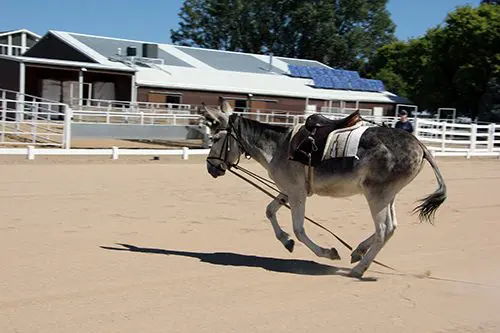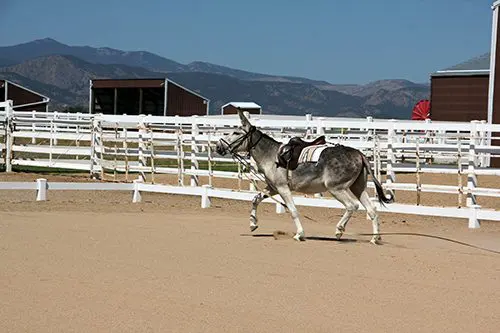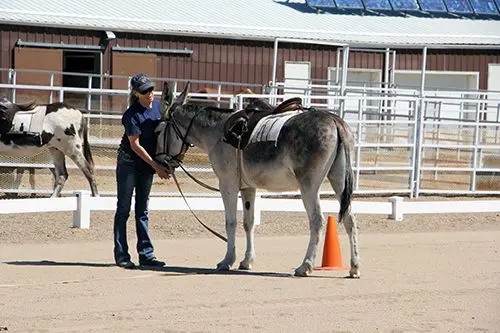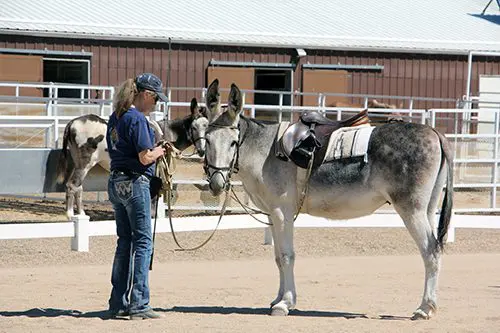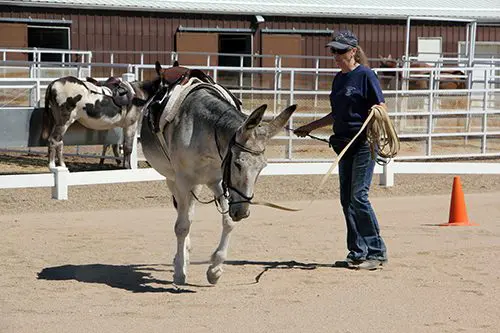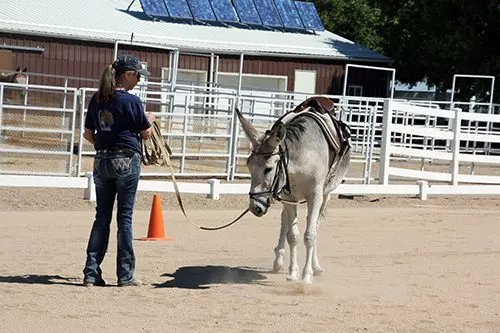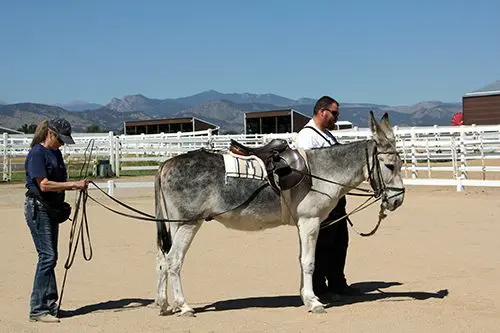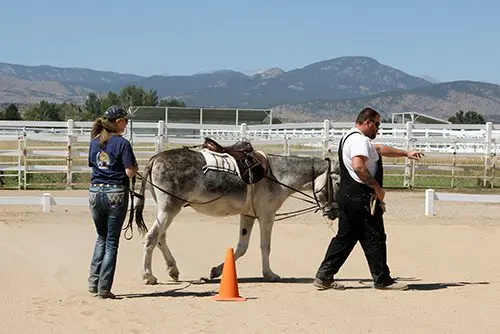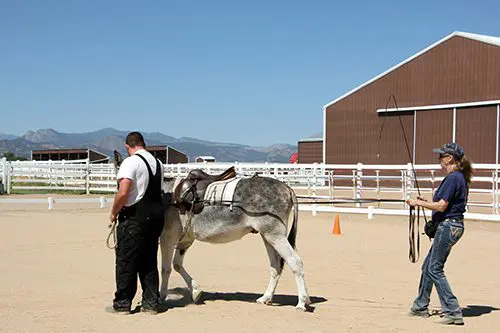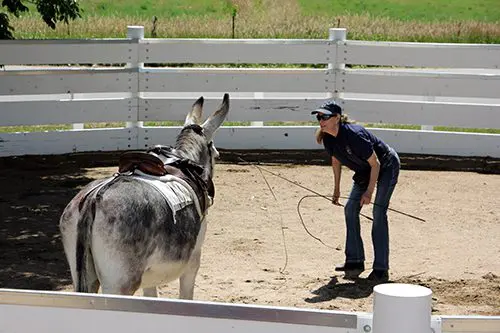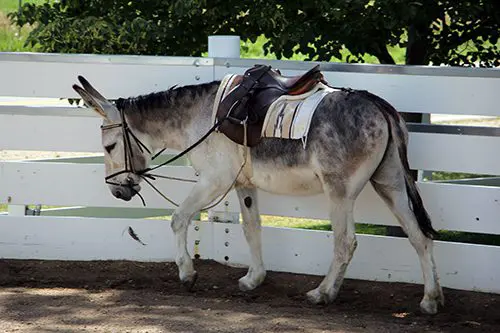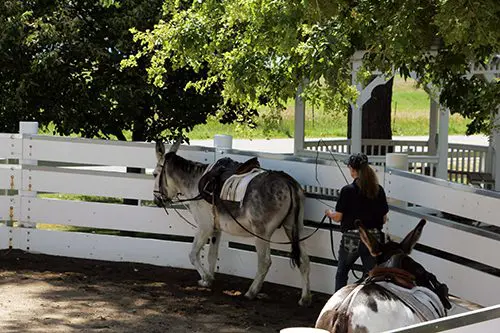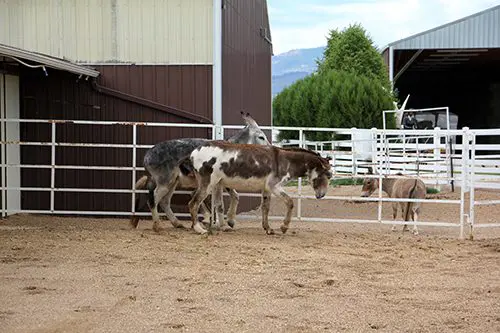
Wrangler


CHASITY’S CHALLENGES: Fun with Friends: 8-4-20
Donkeys love it when you keep things easy, fresh and interesting! Chasity has been doing so well with her lessons with Wrangler lately that I thought we could change things up a bit and add a LITTLE excitement to their routine by adding the mini donkeys, Augie and Spuds! If this is to be a safe endeavor, I will have to break things down into small introductory steps and make frequent evaluations as to what is safe to do and what might not be safe. I want them all to enjoy this time together with me! Seeing the mini donkeys in the Tack barn work station, Chasity is getting already started with a smile on her face!
First, I lunged Chasity by herself to see how she would respond in her “Elbow Pull” and to see whether she would maintain her good postural balance during this lesson. She did lovely at an energized and forward working walk! I was very pleased.
Chasity then bucked up her working trot and although she raised her head just a bit, she kept the “Elbow Pull” loose almost all the time…she is truly improving rapidly!
Next, I ground drove her and again, she did everything just right and maintained her good posture and balance…through the reverses and in both directions!
Chasity’s contact with my hands was steady and light, and she easily did her “S” turns through the middle of the Round Pen gracefully and accurately.
Chasity did a square halt and did the rein back much more easily that she had in prior lessons. She is making marked improvement every week! Yes, we only do these lessons once a week for about 20-30 minutes to get these amazing results!
Chasity and Wrangler always enjoy lunging together, but sometimes he will get a bit slow and cause her to raise her head behind him and put more tension on the “Elbow Pull” than she would do if he was not there. Wrangler spotted Augie and Spuds tied outside and did not want Chasity anywhere near them! That was when I made the decision that now would not be the right time to lunge FOUR donkeys together!
Instead, I tied Wrangler outside and introduced Chasity to Augie and Spuds…they liked each other, so I began lunging them all together! Chasity loved it!
The donkeys, large and small, tracked left and then did a perfect halt…all three of them! As they stood stock still, I rewarded them each one for a job well done!
Chasity surprised me by doing a perfect reverse and then walked behind Augie and Spuds to show them the new direction. Then they too, reversed and followed her obediently! I had to chuckle…who’s in charge here?! Wrangler just hid his face behind the post outside of the Round Pen, hoping no one would notice how left out he felt! Even though Wrangler was a bit miffed, they all had a very good time! At least he was not completely left out! Friends really LIKE to work together!

CHASITY’S CHALLENGES: Yearly Baths: 7-14-20
Each year, I try to pick the hottest week in July to do the equine’s yearly baths. The mules and horses have shed out their winter coats, except for a strip of hair on the mules’ bellies, and the donkeys are getting closer to being completely shed out. This makes a difference when you are trying to get them dry after their baths. They all begin to grow their winter coats in September.
Their natural hair coats will insulate them from the heat and cold and will protect them from insects, so I do not advise clipping them unless you are showing. Even then, it is not advisable to clip the hair inside of the ears! I bath as many as four at a time and in smaller friendly groups like Wrangler and his “Lady Love,” Chasity! I am polite, considerate and respectful, so it is always an enjoyable experience for all! I begin with the introduction to the hose on their front legs.
Wrangler and Chasity enjoy their yearly baths to get off the dirt that has built up during the year. I offer a drink to their lips and afterwards move to their foreheads, being careful not to get water in their eyes or ears. I spray the water gently into their mouths and we “water pick” the teeth! Playful antics like this teach them to always remain calm and keep things safe between us. This keeps interest to a maximum and intimidation to a minimum.
When they are approached in this manner, Chasity and Wrangler can enjoy the cool water on a hot day! Chasity knows I am being careful and doesn’t pull away, then takes a sip from the hose.
I reward Chasity with crimped oats from my fanny pack for being such a good girl. Then I rinse off the oats that were stuck to her whiskers as she gazes at the other equines in the pens nearby who are anxiously awaiting their turns.
Her attention returns to me and I work my way up her forehead to her forelock and ears. I make sure the spray is light and doesn’t sting so she will keep her ears laid back for the rinsing. I would hate to get water in Chasity’s ears, but if by accident I do, I just back off and allow her to shake her head to get the water out before I resume.
We use Tres Semme (Breakage Defense) shampoo and Aussie 3X Conditioner on the manes and tails only, and just water on their bodies to keep their hair coats from drying out. In the case of Chasity’s white legs, I will use the shampoo and conditioner there, too. The result is a healthy and shiny hair coat year round.
I spray the water over their bodies and then follow up with the serrated side of the shedding blade to scrape the dirt from their body. I keep going over each spot until the water runs clear. I pay special attention to the legs and any places that flies might have laid eggs. I will scrape these places with a stiff brush or with my fingernails and apply Neosporin to these spots, and any sores, after they are dry. I scrape off the excess water with the smooth side of the shedding blade. Then Chasity and Wrangler are put on the hot walker to dry.
When Wrangler and Chasity are dry, I sprinkle Johnson’s Baby oil in the manes and tails and spray for flies with Farnam Tri-Tech 14. The baby oil will keep them from chewing on each other’s manes and tails. Those who have sensitive skin around their eyes will receive fly masks. Chasity and Wrangler do not need them. When entering or leaving an area, we ALWAYS execute gates exactly the same way! That way, there is no confusion and chaos that could result in resistant behaviors.
Chasity and all my equines always know exactly what is expected and know exactly what they need to do.
Chasity will be rewarded with her favorite crimped oats for her cooperative behavior. Good manners, and being polite and respectful are paramount to getting your equine’s full cooperation! Even if Chasity does go right out into her pen and roll afterwards, she always seems to enjoy having clean, healthy skin and hair. And, most of all, she enjoys her time with me and looks forward to the next time!

CHASITY’S CHALLENGES: Yearly Baths: 7-14-20
Each year, I try to pick the hottest week in July to do the equine’s yearly baths. The mules and horses have shed out their winter coats, except for a strip of hair on the mules’ bellies, and the donkeys are getting closer to being completely shed out. This makes a difference when you are trying to get them dry after their baths. They all begin to grow their winter coats in September.
Their natural hair coats will insulate them from the heat and cold and will protect them from insects, so I do not advise clipping them unless you are showing. Even then, it is not advisable to clip the hair inside of the ears! I bath as many as four at a time and in smaller friendly groups like Wrangler and his “Lady Love,” Chasity! I am polite, considerate and respectful, so it is always an enjoyable experience for all! I begin with the introduction to the hose on their front legs.
Wrangler and Chasity enjoy their yearly baths to get off the dirt that has built up during the year. I offer a drink to their lips and afterwards move to their foreheads, being careful not to get water in their eyes or ears. I spray the water gently into their mouths and we “water pick” the teeth! Playful antics like this teach them to always remain calm and keep things safe between us. This keeps interest to a maximum and intimidation to a minimum.
When they are approached in this manner, Chasity and Wrangler can enjoy the cool water on a hot day! Chasity knows I am being careful and doesn’t pull away, then takes a sip from the hose.
I reward Chasity with crimped oats from my fanny pack for being such a good girl. Then I rinse off the oats that were stuck to her whiskers as she gazes at the other equines in the pens nearby who are anxiously awaiting their turns.
Her attention returns to me and I work my way up her forehead to her forelock and ears. I make sure the spray is light and doesn’t sting so she will keep her ears laid back for the rinsing. I would hate to get water in Chasity’s ears, but if by accident I do, I just back off and allow her to shake her head to get the water out before I resume.
We use Tres Semme (Breakage Defense) shampoo and Aussie 3X Conditioner on the manes and tails only, and just water on their bodies to keep their hair coats from drying out. In the case of Chasity’s white legs, I will use the shampoo and conditioner there, too. The result is a healthy and shiny hair coat year round.
I spray the water over their bodies and then follow up with the serrated side of the shedding blade to scrape the dirt from their body. I keep going over each spot until the water runs clear. I pay special attention to the legs and any places that flies might have laid eggs. I will scrape these places with a stiff brush or with my fingernails and apply Neosporin to these spots, and any sores, after they are dry. I scrape off the excess water with the smooth side of the shedding blade. Then Chasity and Wrangler are put on the hot walker to dry.
When Wrangler and Chasity are dry, I sprinkle Johnson’s Baby oil in the manes and tails and spray for flies with Farnam Tri-Tech 14. The baby oil will keep them from chewing on each other’s manes and tails. Those who have sensitive skin around their eyes will receive fly masks. Chasity and Wrangler do not need them. When entering or leaving an area, we ALWAYS execute gates exactly the same way! That way, there is no confusion and chaos that could result in resistant behaviors.
Chasity and all my equines always know exactly what is expected and know exactly what they need to do.
Chasity will be rewarded with her favorite crimped oats for her cooperative behavior. Good manners, and being polite and respectful are paramount to getting your equine’s full cooperation! Even if Chasity does go right out into her pen and roll afterwards, she always seems to enjoy having clean, healthy skin and hair. And, most of all, she enjoys her time with me and looks forward to the next time!

CHASITY’S CHALLENGES: Lunging Together: 6-10-20
Chasity had no way of knowing that she was about to graduate from the Hourglass Pattern to the Round Pen today, nor did she really care! She knows that every experience with me is happy and rewarding! So, she was waiting patiently at the stall door for me to come get her after I had already gotten Wrangler, her beau, from his stall! She put on her “happy face” and proceeded to the Tack Barn with a spring in her step!!!
She was particularly happy to see Wrangler standing at the work station! I cleaned both of their eyes, ears and nostrils with no problem at all! They were both eager to find out what was coming next!
After her initial introduction to the “monster vac,” this time she did not even bat an eyelash! It was of no consequence to her anymore…she was BRAVE now! I rewarded her and marveled at how her neck was improving! The fat was disappearing and her neckline was becoming straighter. Hallelujah!
I asked Chasity to do her stretches first to the right and then to the left. Her response was becoming much more flexible and symmetrical on both sides.
The Courbette (on Chasity) and the Passier (on Wrangler) are two used All Purpose English saddles that I bought over 35 years ago, that fit all my mules and donkeys, and are in as good condition today as the day that I bought them! I centered them on their backs and adjusted the crupper to keep them in place!
I bridled them both and took Wrangler to the Round Pen first. Then I tied Chasity on the outside of the Round Pen and she watched while I lunged Wrangler.
Then it was her turn! I adjusted the “Elbow Pull” self-correcting restraint to the right tension and asked Chasity to flex at the poll. Then we began lunging. She leaned on the “Elbow Pull,” but it kept her from hollowing her back and neck while still allowing her to reach well underneath her body with her hind legs.
After five rotations in one direction, I stopped her and asked for a reverse. She hesitated, but eventually understood what I was asking of her and happily trotted off. She did make me work a bit to keep her going, but she was beginning to relieve a bit of the tension on the “Elbow Pull.”
Since things were going so well, I rewarded Chasity and flexed her neck again. I decided to allow Wrangler to help show her how it is done for five more rotations in each direction. That would be all I would need to do on a 85+ degree day with their shedding not quite completed. Wrangler was amazing! They had not been turned out together yet, so I thought he might be silly with her, but he was all business!
Of course, Wrangler did the reverse quickly and perfectly while Chasity took a little persuading. Wrangler just walked confidently and patiently, keeping his good posture with the “Elbow Pull” loose, while he waited for her to catch up. For two thirteen year olds, they were awesome!
Although Wrangler has been with me for three years, and Chasity for only three months, I find it amazing how quickly they happily come to their ideal equine posture. They exit their lessons renewed and refreshed!

WRANGLER’S DONKEY DIARY: Fine Tuning Wrangler’s Response: 9-22-20
Wrangler always eagerly awaits his weekly lessons! When things are predictable and are not “drilled,” your equine will look forward to his time with you. I always try to keep lessons short (30-40 minutes), done in a logical order and consistent in the task executions. For instance, we always walk the same way, with the lead in my left hand, with a loose connection to his head to encourage self-carriage, repeated verbal commands and I walk with my feet in sync with his front legs. The gates are always executed the same way. He is rewarded with crimped oats from my fanny pack when halted and waits patiently while I close and latch the gate. Even though Chasity is tied outside of the Round Pen, Wrangler’s attention is 100% on me. Minimizing distractions by being consistent with the way we do things will create a solid base of habitually good behavior.
Wrangler continues to stand quietly while I make sure his saddle is centered in the middle of his back and the tension on the crupper is adequate, but not too tight. He should be able to relax his tail. I check both girths to make sure they are snug but not too tight (the front girth tighter than the rear girth), adjust the tension on the “Elbow Pull” and make sure the fleece at the poll is centered to prevent undue chafing when he has to “lean” on the “Elbow Pull.” The “Elbow Pull” will not tie his head down, but it will prevent him from raising his head so high that he inverts his neck and spine. It will assure that he is in a good balanced equine posture during his workout.
I first ask Wrangler to walk for five rotations before asking him to trot. Occasionally, he will be so full of energy that he offers the trot first. If he trots, I just adjust and let him do five rounds of trot first and let him walk five rotation afterwards. To start, I only asked for walk and trot until Wrangler began to break into canter by himself. I then added one rotation at canter after the five rotations at trot before allowing him to walk.
I will add one more rotation at canter in each of the upcoming lessons. Then his warm-ups will consist of five rotations of each…walk, trot, canter, walk…then a reverse, and the same progression in the opposite direction before mounting him. He should always slow to a walk before executing the reverse so it is done in good postural balance.
This will begin to improve his balance and build his bulk muscle symmetrically.
After checking both girths one more time, Wrangler stands stock still as I mount him. I offer his oats on both sides as I did in our first mounting session in the Tack Barn. This is to make sure I keep his attention on ME! The oats are taken politely. He fully understands that these are NOT treats, only REWARDS for good behavior.
Once mounted and seated in balance, I ask Wrangler for a rein back with a few more steps than he had done in his previous lesson. He responds nicely to the squeeze/release motion of my little fingers.
I keep a very light contact with the bit as we proceed forward. We add circles at random points along the rail to add variety to the workout and keep it interesting. We work on staying erect while he bends to the arc of the circles through his rib cage.
Wrangler’s “Elbow Pull” remains consistently loose as he walks leisurely along the rail and executes the “S” turns for changes in direction.
Wrangler gives Chasity a wink as he passes the spot where she is tied along the rail. She is proud of how well her “beau” is doing and watches intently! Wrangler is soft, flexible and elastic in the bridle. This is exactly what I want from him. We will be able to graduate to a larger area next week!
Wrangler spotted a jogger coming toward us along the road and didn’t quite finish his square halt, but halted nevertheless. I prudently waited for the jogger to go by before I asked him for a rein back and he complied easily.
I think too many of us get in too much of a hurry to RIDE and forget that our equine athletes need the same consideration from us that human athletes get from their coaches. They need to do exercises that prepare their bodies for the “game.” When they are adquately prepared, their skeleton is symmetrically supported, joints are able to operate as intended and do not develop arthritis from uneven wear of the cartilage, and the internal organs can function in good health at maximum capacity. When we are patient and take the time to prepare our equines properly, there is much to be gained…a happy and willing equine companion that is capable of performing to their optimum ability. Training really CAN be safe and resistance-free! Being herdbound is not an issue because they really enjoy being with YOU as much as, if not more than, they enjoy being with their equine friends!
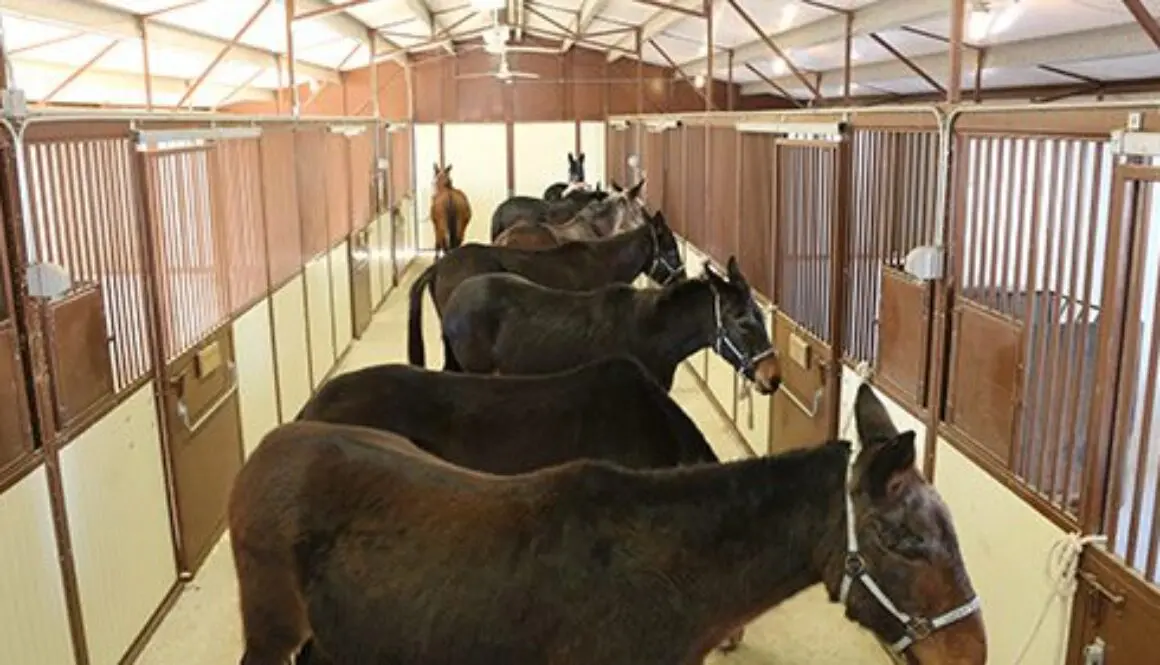
LTR MULES: Efficient Grooming Practices 12-1-21
On November 22nd, of 2021, I posted, on my MEREDITH HODGES PUBLIC FIGURE Facebook page, information about how to maintain your tack and equipment, and how to keep a neat and tidy tack room. There were a lot of comments about it and many people indicated that they thought it would be easy if you had the staff that I have.
Just for the record, when it comes to my equines and their tack and equipment, I do most of the work myself. My TWO guys do clean the stalls and runs daily, and the larger dirt pens weekly when the animals are overnighted there, and they do feed in the mornings, midday and evenings. TWO of my girls take care of the inside and external cleaning of the multiple buildings that we have, and they condition the tack and equipment as needed, but mostly every three months because we clean things as we use them.
My THIRD girl assists me in the office checking the website and Social Media connections, making Social Media posts (with the exception of Facebook that I do myself), editing articles, advertising and the newsletter, fulfilling orders and MUCH more. TWO of the girls and I film and take photos of EVERYTHING we do so we have material for our posts, articles, video Training Tips and Documentaries. We put these together with our TWO remote videographers and we have ONE remote graphics artist that also assists with publications. Our JASPER MASCOT also doubles as a website tech person. So, we have a VERY SMALL staff to cover all the work that we do. We are prompt in doing what we do because we want to provide all of you the information that you need to have the same success with your equines that we have with ours. In this post, I will address how I efficiently keep all 17 of my equines clean and healthy.
I find that when you have a regular weekly grooming routine along with good environment cleaning practices, the animals do not seem to get as dirty as they would otherwise. Spring is obviously the most intensive time of the year because of mud and shedding, but during other times of the year, grooming can go quickly. During the summer months, they have short hair coats and will only need to have bridle paths trimmed, faces, ears and nostril cleaned, Johnson’s Baby oil in the manes and tails, Neosporin for any cuts and scratches, and a quick go-over with the Dandy brush. Since I keep them barefoot with regular trims every 6-8 weeks, they rarely need their feet cleaned. I carry the grooming tools in a bucket and visit them wherever they happen to be, either in their stalls or in turnout. Because they are all taught the same manners, they come to me and line up for their turn wherever they are.
We have had good weather this fall, but with the lack of moisture, they are all pretty dusty. Since we are using my Tack Barn as an art studio and getting the BELLE, JASPER, MOXIE & KYLIE bronzes ready to be cast for their placement in our newest project, the OLDE WESTERN TOWN OF ASSPEN here at the ranch, I opted to vacuum everyone in the alleyway of the barn.
The first thing I did was to have them exit their stalls and be tied in the alleyway. I brought in Augie, Spuds and Billy from their barn and added them to the eight mules from the South Barn. As I retrieve them, I ALWAYS open the door, ask them to come to me, reward them and then put on their halter. They learn to stand quietly and will not exit the stall until I give them permission to do so.
So I can be hands-free with the halter, I will often allow them to eat their reward directly from the fanny pack of crimped oats that I ALWAYS wear around my waist. If they get pushy, I will say, “NO!” and put my hand up like a stop sign and ask them to back off. If that doesn’t work, a quick slap to the side of their mouth after they have been asked does work. Consistency in MY behavior is key!
They have all been introduced to the vacuum cleaner and stand quietly while I go from one to the next. If they start picking at each other, I just holler the name of the perpetrator and say “NO!” VERY LOUDLY! They always stop because they know the next thing is a pop on the rump from me!
I am always aware of each animal, but I do not “move over” for them. I ask them to “move over” for ME. Then they are rewarded with crimped oats. Once they learn, for instance, that I need to return the vacuum to its spot, and that they will all get rewarded for standing quietly, they give me my space as I work around them, even during rolling up the extension cords!
Since I have so many animals, I do have to refill the fanny pack often, so I keep a full bucket available in a convenient spot for refills. Once they are all vacuumed, I ten move down the line and wipe everyone’s faces. They get their eyes, ears and noses cleaned thoroughly. They quickly learn to accept the process and then I reward them once they are all done. When I do them individually before riding, I will reward each immediately after each task. When they are all together, they will behave better when they have to wait to be rewarded when they are ALL done with each task. Then I go down the line and sprinkle Johnson’s baby oil in all their manes and tails and reward their good behavior when that is all done.
My 28 year old mule, Merlin, poked his eye on a tree branch when he was a yearling. I opted not to have his eye removed, so we have been treating it for 27 years. We keep him in a fly mask all the time to keep the dirt and debris from irritating it. Twice a day face wiping keeps it sanitary and it is easy enough to do at feeding time. We just carry a wet rag with us when we see him.
When they are all done, I lead them back to their stall, send them in while I stay at the door and ask them to turn back to me for their reward. As they chew their reward, I remove the halter and bid them a fond farewell!
With the 11 mules and mini donkeys finished in the South Barn, I next go to the North Barn to repeat the process with the remaining six animals, two Large Standard Donkeys (Wrangler & Chasity), a miniature mule (Francis), a miniature horse (Mirage) and two saddle mules (Jubilee & Brandy).
Again, I ask them to come to ME, give them their reward and then halter them as the chew. They are all happy to stand still until I tell them they can walk out the door.
I repeat the whole process with the vacuum cleaner and again, they have all been trained to accept it, so they stand quietly and happily. I do believe that they really DO enjoy being cleaned…even if they do go back and roll almost immediately…LOL!
Then comes the face-wiping followed by the Johnson’s Baby oil in the manes and tails. I do not cut their bridle paths in the winter. It gets very cold here and I don’t want them to lose heat from their bodies.
Then it is time for them to be returned to their stalls. I have two rescues (re-trains) in this group and they watch intently as the old troopers enter their stalls and behave impeccably!
When Chasity was returned to her stall, I asked her to walk through the narrow space between my truck and the wall of the barn. My assistant was filming from the bed of the truck and as I said earlier, we do not move over for them! Chasity walked quietly through the narrow space, did not rush or push me, but followed obediently. She was sent into her stall, turned around and got her reward. Then, it was Wrangler’s turn.
Francis is a mini mule that I got 10 years ago and to this day, she is still suspicious of humans, but is learning to trust. She can be fully groomed in her stall with no halter, but she can become quite a handful when outside the stall. Her natural reaction is to bolt and run any time she get the chance. When I return her to her stall, I set her up for success by looping the end of her lead rope around the stall bar so if she does bolt, she won’t be able to pull the lead rope from my hand and will be forced to turn around and face me. She didn’t even try to bolt this time, kept the rope loose and returned to me for her reward. Then I went and got Mirage, our 26-year-old miniature horse, and returned him to his stall. The grooming of all 17 animals only took me 2 hours! Organized practices and teaching good manners makes all the difference!

WRANGLER’S DONKEY DIARY: After the Winter Break: 3-29-21
Wrangler is such a goof ball! Because Wrangler would lock up in front of the Tack Barn and not want to walk over the grate, I got smart and learned to take Chasity to the Tack Barn first. Then, he didn’t even notice the grate and walked right in! However, he gets pretty rambunctious about waiting his turn. I could lead them both at once, but he needs to learn to be by himself with me sometimes…and BEHAVE! When I first got Wrangler, he would get excited like this and then just try run over me when I opened the stall door. Through repetition and humane discipline, I changed his behavior with Behavior Modification, a systematic reward system of training. To be successful, one needs to target the behaviors that need to change, set up the equine for success and promptly reward the positive behaviors as they occur. AND, you need a specific, consistent and humane way to stop bad behaviors in their tracks when they occur. We work on the premise of POSITIVE REINFORCEMENT, but we also need to learn how to use NEGATIVE REINFORCEMENT if one does not want to be hurt, or even killed, by these VERY LARGE and STRONG animals!
The negative reinforcement that I use really works. When he got aggressive the first time, I raised my hand like a stop sign and when he did not stop, he got a firm slap to the side of his mouth as I said, “NO!” as loud as I could. I promptly raised my hand like a stop sign in front of his face again after which he started to turn back around. I quickly took a handful of oats from my fanny pack, took a step forward and offered him the oats. He did a double-take and came back for the oats to which I replied, “Thank you for giving me my space!” Going forward, he still occasionally gets too aggressive, but he always stops when I put my hand up like a stop sign in front of his face and takes a step back. He won’t need to be slapped again since this was done correctly the first time. He remembers!
As soon as I open the stall door now, Wrangler immediately stops his antics and becomes a gentleman that can be rewarded. He stands stock still while I put on the halter and then drops his head at my shoulder. I hold his lead rope in my left hand while pointing in the direction of travel with my right hand. I tell him to “Walk on” and look down to see what foot he is leading with and follow his front legs, step for step. We get IN SYNC with each other and I lead him that way from the time he leaves his pen to the time he returns. I do this the very same way with ALL of my equines ALL of the time. Consistency breeds familiarity and compliance.
Donkeys have issues with chronic runny eyes and noses. The way to stave off any infection is to clean their eyes, nostrils and ears with a damp towel daily. This also encourages them to accept handling around their face in general.
Donkeys are inherently desert animals and can severely founder or colic on lush feed. Symptoms of too rich feed will be manifested in the hooves as abscesses, crusty growth, collapsed heels and frogs, or just plain stress rings. Wrangler has abnormally small rear hooves and it is important that his core strength is developed in good postural balance to make sure the weight distribution is even so none of his hooves are carrying too much weight for his size.
Wrangler is rather flat-withered and needs a saddle that will “hug” his body, leaving ample room for his spine.
I initially tighten the girth snug, but not too tight. The crupper is adjusted so the tail lies comfortably.
I gently press on the bars of his jaw to open his mouth for the bit and carefully bring the crown of the bridle over his ears, protecting them with my hand. Being polite and considerate will get much more cooperation from your equine.
I adjust all the straps on the bridle so it is comfortable, paying special attention around the ears. The drop noseband helps him learn to hold the bit properly. I always gradually tighten the girth over several times.
The walk to the Round Pen is still IN SYNC…all three of us! Wrangler’s “Elbow Pull” postural restraint is adjusted and he is reminded how to release the tension.
Wrangler’s posture has greatly improved over three years and has given him added strength, endurance, stamina and animation to his gaits. He defies the slow and pokey characterization of donkeys in general! He’s a true athlete!
Wrangler and Chasity do a very nice reverse in sync with each other. Wrangler resumes the working walk.
Five rotations at walk, five rotations at trot, reverse and repeat in the other direction. We do 3 sets with a 3-minute break in between. Rewards are in order with every halt. With every halt, Wrangler is asked to rebalance and square up!
Then I begin riding with three rotations at trot in each direction. I carry a riding crop in case he needs a little encouragement to keep going. If he gets too tired, we call it quits and will do more another day.
I always end the sessions with a halt and rein back. Then I dismount and reward him again for a job well done!
Back in the Tack Barn at the work station, I carefully remove the bridle. I always hold the halter crown strap in my right hand while removing the bridle. I then slip the bridle onto my left arm, pick up the nose band of the halter in my left hand, bring it over his nose and buckle the halter. This way, if he pulls away, I still have my arms (and halter) around his neck to hold on to him.
We make our way back to the barn and Wrangler waits patiently while Chasity enters the stall first (Ladies first, you know!). He follows her sedately into the stall and they both turn around to me to have their halters removed and to receive their rewards. Wrangler “suggests” to me politely that I should hurry with Chasity’s halter and get to the rewards…QUICKLY! He’s still hungry!!! Silly boy!!!

CHASITY’S CHALLENGES: Maintaining a Happy Donkey: 3-2-21
When Chasity first arrived, we needed to keep her in quarantine, away from the other animals for a minimum of two weeks. Over the past 41 years, we altered our facility to an all-steel facility. Reduced maintenance costs enabled us to proceed converting from wood and wire to steel until we completed the process. This has greatly reduced the overall maintenance costs for the entire ranch, enabling us to purchase steel panels for the barn runs. It was easy to quarantine Chasity safely and still allow her company (at a distance, of course!) and an introduction to her future stable mate, Wrangler. About every five years, we do have to spray paint the panels to keep them looking new, but this is a small price to pay for a happy donkey!
Once out of quarantine, Chasity and Wrangler were stabled next to each other. All of our runs are bedded with four inches of pea gravel. This promotes good drainage and keeps things from getting muddy. This, in turn, provides a hard surface for good hoof health and will not chip their feet because of its rounded shape. Each of our donkeys is given a soccer ball for play in the smaller areas. The ground surface is also soft and comfortable enough for them to lie down without causing shoe boils or sores. They learn to come by calling them to the end of the runs and rewarding with oats.
The mini donkeys’ pens are the same way, as is the road around the sandy dressage arena where they can also be turned out in the larger dirt area when it is not in use. They really enjoy a good roll in the sand.
Donkeys are desert animals and can easily become obese when exposed to green pastures. I only take my donkeys out to pasture to play with me.
My 60’ x 180’ indoor arena is lined with steel panels. I have a 45’ Round Pen at one end with obstacles inside the side gates around the south end. The enclosed area makes for good obstacle training with minimal distractions. Round Pen work and turnout in the open area during bad weather is completely safe and NON-DESTRUCTIVE!
At first, Chasity would not come to me at the stall door, but after being chased once into the stall to be haltered, she soon gave in easily. I always halter in exactly the same way, in the same place. They love routine.
The oats reward assures that she will repeat the behavior. After only one lesson, she now comes to me every time to be haltered. For clean, dry stalls, we bore a 2’ wide x 4’ deep hole in the center, fill it with 1 ½” rock, cover it with four inches of pea gravel and put rubber mats on top. The pea gravel is held in with 2” x 6” boards bordered by angle iron.
Since we had no animals in the north stalls, we took down the panels and made a large turnout area bedded in four inches of pea gravel for Wrangler and Chasity. It was plenty large enough to romp and play…and not get muddy!
When I am out and about the barn, I reinforce Wrangler and Chasity’s will, as well as all the others, to come to me for their oats reward. We keep bulk rock, pea gravel and structural fill in bays behind the indoor arena.
When the equines are in turnout, we replenish the pea gravel as needed with the Skidsteer.
Wrangler and Chasity, our miniature donkeys Augie & Spuds, miniature mule Francis and miniature horse Mirage also have alternate access to a very large 2 ½ acre dirt pen…Large Standard donkeys one day, miniatures the next.
When it is dry, they can take turns on alternate days in the larger area to stretch their legs and buck to their hearts desire. They do not seem to miss being in the pasture with this kind of management and they really do stay very healthy. We have no incidence of colic, founder, abscesses, skin irritations, rashes or obesity.

WRANGLER’S DONKEY DIARY: Riding in the Open Arena: 10-6-20
A lot of people tell me they have problems when their jennets or molly mules are in heat. And, they expect the behaviors of their gelding to change drastically when they are castrated. In my experience, it really doesn’t make much difference if you have a fair and equitable management and training program. When their bodies are managed in a healthy way and they are consistently taught good manners, they will be willing and able to perform well regardless. I always approach training in a fair and equitable manner that does not throw too much at them all at once so as to avoid anxiety. Wrangler and Chasity both appreciate this (as did my jack, stallion and other females). It wasn’t until AFTER this lesson that I realized that Chasity was in heat and Wrangler was EXCITED about it! This program is a slow, logical and sequential approach that the equines truly appreciate and respond to positively no matter their mood. The results are miraculous!
Today, we were to begin with an interview about donkeys. Wrangler watched intently while Robbie wired me with the microphone. Then we went to the center of the Round Pen where I set him up and asked Wrangler to stand quietly while we did the interview, and he did what he was told. Such a good boy!
After the interview, Wrangler did his exercises of five rotations at walk, trot and even a little bit of canter. He is getting really good about stretching his spine from head to tail and his flexibility is greatly improved.
Since Wrangler had previously bolted with the lunge line in the dressage arena, I thought another lesson might be in order. I asked for the halt. Then we went to the open arena where I tied the end of the lunge line to the his bit with four inches to spare that I ran under his chin and snapped to the bit ring on the other side. This would prevent the bit from being pulled through his mouth.
I first lunged him to the right at walk and trot, halted him and changed the line to the other side. I gave a slight pull on the lunge line as his outside front leg was in suspension as a cue to keep him on the arc of the circle.
Wrangler did very well, so I stopped him and he stood quietly while I rolled up the lunge line. He followed me when I put away the line and stood still again while I prepared to mount.
Once mounted, the reward was in order followed by a rein back. He was offering more steps in each new lesson with only very slight squeeze/releases from my little fingers.
We did a very well-balanced turn on the haunches and made our way into the Hourglass Pattern. Wrangler proceeded forward with an energized working walk.
Wrangler remained erect in his body carriage as we made our way through the pattern, bending his body appropriately through his rib cage to the arcs of the turns and moving in good posture on straight lines.
Wrangler remained soft in his response to my hands, seat and legs. Donkeys are notorious for leaning against pressure, so it was imperative that I kept myself relaxed and “giving” to his movement.
Wrangler’s internal pendulum kept him moving through the Hourglass Pattern in a very nice balance, first through the pattern one way, across the diagonal and again in the opposite direction. My inside leg at the girth on the turns helped him to stay erect while my outside leg was well back to support the bend and encourage impulsion.
Wrangler obediently executed a square halt followed by a nice rein back with the lightest of cues from my fingertips. When you are patient and spend the time to train your equine this way, it makes a world of difference in their gaits and produces an incredibly smooth ride!
Wrangler stood quietly during the dismount and went through the gate perfectly! It was truly a resistance-free lesson! That is what you will get when you spend time on accuracy and wait for speed to come later.
Wrangler and Chasity both stood stock still while I got Chasity untied, then we all walked happily in sync together back to the Tack Barn! Leading them together is never a problem! The boundaries to good behavior have been established from the very beginning. They both know clearly what is expected!

WRANGLER’S DONKEY DIARY: Riding the Hourglass Pattern: 9-29-20
There are differences in jacks, geldings and jennets, but I have found them all to have their individual redeeming qualities. Wrangler is carefully surveying the environment while Chasity walks obediently at my shoulder. Wrangler is much more playful while Chasity is sedate. My jack, Little Jack Horner, was always an energetic, enthusiastic, fully-charged male with extraordinary ability! What they ALL have in common is their exceptional intelligence, energy conservation and strong sense of self-preservation. What has produced the most success in the management and training of all my equines has been a logical, sequential and equitable approach, executed with a polite attitude, good manners, kindness, consideration, respect and a fair reward system. If I want the best from them, I have to set a good example myself. Chasity and Wrangler politely go through the gate into the area where each will not be interrupted and will patiently wait their turn.
Wrangler is now light in the bridle in the Round Pen and ready to begin work in the Hourglass Pattern in the open arena. Since I have to use both the Round Pen and the open arena, I tie Chasity in the obstacle area so she will not need to be moved until it is her turn. Then Wrangler and I proceed to the Round Pen for his warm-up exercises where he will lunge five rotations in each direction at walk, trot and canter in both directions with a reverse in between. Too much shuffling around can cause anxiety. I prefer that they both remain calm and obedient, so I set them up for success.
Wrangler politely accepts my adjustment on his bridle, “Elbow Pull,” saddle placement and girth, then proceeds forward at the walk in good equine posture. His “Elbow Pull” remains loose and is only there as a reminder in the Round Pen and as a support should he need it when I add my extra weight under saddle in the open arena.
Wrangler trots obediently upon the verbal command and after five rotations transitions to canter. He is now up to three rotations at canter in each direction. I will add one more rotation in each direction with each new lesson.
I slow him to a walk, do a well balanced reverse and he then proceeds once more at the walk for five rotations.
Wrangler picks up the trot promptly upon request. After five rotations, he canters for three more rotations. I will add one more next time. His overall balance at canter is slowly improving with each new lesson!
Improvement comes rapidly when you don’t try to get too much too quickly. Wrangler is eager and ready to be ridden!
I ask Wrangler to come through the gate and he turns back to me to receive his reward. Then I mount and give him another reward from his back. I truly appreciated his well-practiced good manners!
Once mounted, I ask for the familiar rein back and we then proceed forward into the Hourglass Pattern. Wrangler stays light in the bridle and takes gentle directional nudges from my calves in sync with the direct rein cues.
Wrangler remains upright in his balance, bends through his rib cage through the arcs in the pattern, and halts squarely and promptly upon command.
Preparing your equine with PLENTY of groundwork, the right kinds of exercise and use of the “Elbow Pull” to help build his core strength adequately in good posture to support a rider BEFORE you get on makes all the difference in the world! You are building a new HABITUAL way of moving.
Wrangler is strong in his balance, light in the bridle and promptly responsive to the cues from my seat, legs and hands. He halts squarely and reins back easily when asked.
When their balance is not constantly interrupted, they only need a weekly workout and can practice their posture efficiently in turnout each day on their own! If you WANT to work more, you can, but always be ready to leave one day of rest between 30-40 minute workout days. I always want my equines to ENJOY being with me and not get sour!

CHASITY’S CHALLENGES: Riding the Hourglass Pattern: 9-29-20
After extensive work in the Round Pen getting Chasity and Wrangler light in the bridle, we are finally ready to graduate to the Hourglass Pattern in the open arena. They enjoy working together, so I just take them both together and tie one outside the working area while I work with the other. We only do these lessons weekly, but they seem to practice good posture on their own during turnout in between lessons. Their play and rest patterns are changing and their posture is improving dramatically. They can now support my weight efficiently in the saddle, so it is now time to hone their skills in a more open setting where we can work more freely. They could trot while sustaining their good postural balance in the Round Pen without my added weight, but that is a pretty restricted place to introduce the trot with my weight in the saddle. So I will tie up Wrangler with his “Elbow Pull” while I work with Chasity.
As always, she leads easily, politely negotiates the gate and stands quietly while I adjust her “Elbow Pull” and adjust her equipment. I will tighten the girth a bit more for lunging to hold the saddle in place. I always tighten the girth a little at a time and not all at once for her comfort. She appreciates my consideration.
In preparation for riding, I will lunge Chasity first. When I ride her, I want her sufficiently warmed up and responsive to perfecting our communication skills. The five rotations at walk, then trot in each direction is sufficient exercise with some speed as she is now well-balanced while performing these tasks. The faster gaits under saddle will come later.
Chasity executes a very nice reverse and immediately slows to the walk, maintaining her good posture. When they are in a good equine posture, the entire length of the spine is stretched, causing space and elasticity between the vertebrae.
If the equine is perpetually allowed to carry their head too high, the vertebrae can become stuck and calcified too close together and over time can cause a condition called “Kissing Spine” that keeps the spine rigid and inflexible.
After a sufficient warm up with the addition of a bit of canter while tracking to the right, Chasity is ready to be ridden in the Hourglass Pattern. She obediently comes out the gate and turns to me for her reward.
I politely mount, settle onto her back softly and offer her reward as I did in the Tack Barn and then in the Round Pen. She stands absolutely still.
Then we do a rein back before moving forward into the Hourglass Pattern. Contrary to popular belief, this “pattern training” will allow Chasity to concentrate on the details of tracking forward, bending and staying light in the bridle.
The arcs and turns in the Hourglass Pattern allow Chasity’s internal pendulum to swing from side to side and come to rest at dead center when she finally halts. She maintains straight lines and bends to the arcs through her rib cage.
When an equine is perpetually schooled on the rail or in too many circles in one direction and then another, this radical movement does not allow the internal pendulum to become centered and balanced.
There is an optical illusion that takes place when riding the rail that “pushes” the balance continuously to one side. Straight lines become difficult and bending will be stiff at best.
This swaying in the Hourglass Pattern from one arc to another keeps the internal pendulum moving freely from side to side while the equine moves freely forward. It produces fluid motion and relaxation in the equine.
All of this keeps the animal responsive, light in the bridle and facilitates good postural movement that results in squared halts and straight rein backs. They enjoy their work because it FEELS good!
Chasity stands still while I fish in my pocket for her final reward for a job well done! Her balance is solid!
We then go back to the Round Pen area to retrieve Wrangler from his “spectator seat!” Wrangler and Chasity have been taught exactly and consistently the same way, so they are quite maneuverable and willing to do as I ask. I have not experienced a “balky” donkey or mule in years!

WRANGLER’S DONKEY DIARY: Fine Tuning Wrangler’s Response: 9-22-20
Wrangler always eagerly awaits his weekly lessons! When things are predictable and are not “drilled,” your equine will look forward to his time with you. I always try to keep lessons short (30-40 minutes), done in a logical order and consistent in the task executions. For instance, we always walk the same way, with the lead in my left hand, with a loose connection to his head to encourage self-carriage, repeated verbal commands and I walk with my feet in sync with his front legs. The gates are always executed the same way. He is rewarded with crimped oats from my fanny pack when halted and waits patiently while I close and latch the gate. Even though Chasity is tied outside of the Round Pen, Wrangler’s attention is 100% on me. Minimizing distractions by being consistent with the way we do things will create a solid base of habitually good behavior.
Wrangler continues to stand quietly while I make sure his saddle is centered in the middle of his back and the tension on the crupper is adequate, but not too tight. He should be able to relax his tail. I check both girths to make sure they are snug but not too tight (the front girth tighter than the rear girth), adjust the tension on the “Elbow Pull” and make sure the fleece at the poll is centered to prevent undue chafing when he has to “lean” on the “Elbow Pull.” The “Elbow Pull” will not tie his head down, but it will prevent him from raising his head so high that he inverts his neck and spine. It will assure that he is in a good balanced equine posture during his workout.
I first ask Wrangler to walk for five rotations before asking him to trot. Occasionally, he will be so full of energy that he offers the trot first. If he trots, I just adjust and let him do five rounds of trot first and let him walk five rotation afterwards. To start, I only asked for walk and trot until Wrangler began to break into canter by himself. I then added one rotation at canter after the five rotations at trot before allowing him to walk.
I will add one more rotation at canter in each of the upcoming lessons. Then his warm-ups will consist of five rotations of each…walk, trot, canter, walk…then a reverse, and the same progression in the opposite direction before mounting him. He should always slow to a walk before executing the reverse so it is done in good postural balance.
This will begin to improve his balance and build his bulk muscle symmetrically.
After checking both girths one more time, Wrangler stands stock still as I mount him. I offer his oats on both sides as I did in our first mounting session in the Tack Barn. This is to make sure I keep his attention on ME! The oats are taken politely. He fully understands that these are NOT treats, only REWARDS for good behavior.
Once mounted and and seated in balance, I ask Wrangler for a rein back with a few more steps than he had done in his previous lesson. He responds nicely to the squeeze/release motion of my little fingers.
I keep a very light contact with the bit as we proceed forward. We add circles at random points along the rail to add variety to the workout and keep it interesting. We work on staying erect while he bends to the arc of the circles through his rib cage.
Wrangler’s “Elbow Pull” remains consistently loose as he walks leisurely along the rail and executes the “S” turns for changes in direction.
Wrangler gives Chasity a wink as he passes the spot where she is tied along the rail. She is proud of how well her “beau” is doing and watches intently! Wrangler is soft, flexible and elastic in the bridle. This is exactly what I want from him. We will be able to graduate to a larger area next week!
Wrangler spotted a jogger coming toward us along the road and didn’t quite finish his square halt, but halted nevertheless. I prudently waited for the jogger to go by before I asked him for a rein back and he complied easily.
I think too many of us get in too much of a hurry to RIDE and forget that our equine athletes need the same consideration from us that human athletes get from their coaches. They need to do exercises that prepare their bodies for the “game.” When they are adequately prepared, their skeleton is symmetrically supported, joints are able to operate as intended and do not develop arthritis from uneven wear of the cartilage, and the internal organs can function in good health at maximum capacity. When we are patient and take the time to prepare our equines properly, there is much to be gained…a happy and willing equine companion that is capable of performing to their optimum ability. Training really CAN be safe and resistance-free! Being herd bound is not an issue because they really enjoy being with YOU as much as, if not more than, they enjoy being with their equine friends!

WRANGLER’S DONKEY DIARY: Wrangler’s First Ride: 9-15-20
Wrangler has now completed his preparation for efficiently carrying a rider while staying in good equine posture with adequate core strength. Doing these kinds of logical and sequential exercises in a consistent manner makes all the difference in an equine’s physical development and mental attitude. Groundwork needn’t be boring for either you or your donkey. Doing these exercises the same way, every time, creates an unbreakable bond and deep understanding of what is expected between you. Before mounting your donkey in the Round Pen, there is one more interim step that needs to be done to keep your donkey standing still and his attention on you as you mount him. In the grooming area, I will mount the donkey and have him take oats from both sides of his body as we stand there. Then we will go to the Round Pen, do the preparatory lunging he has done before and mount in the same fashion. This will set up your donkey for success!

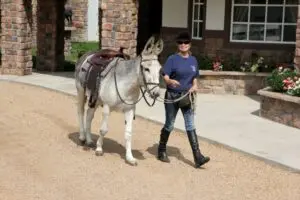
By now, your donkey should know his verbal commands and will not be compelled to just take off at the trot. He will walk leisurely along the perimeter of the Round Pen until you ask for the trot. He will remain in good posture and keep the “Elbow Pull” loose throughout his workout. He will have a rounded topline and overall balance that can easily support the added weight of a rider. Wrangler is doing beautifully!
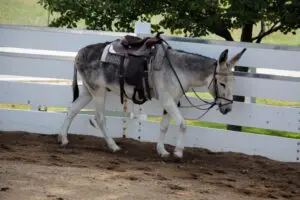
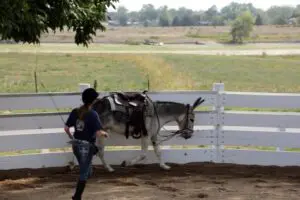
After five rotations at walk and five rotations at trot, I ask Wrangler to slow to a walk. I then turn away from him in the opposite direction he is traveling and step in front of him to encourage him to reverse.
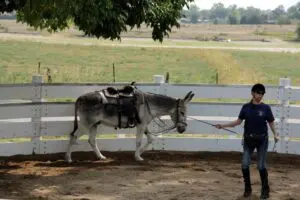

Then I send him to the rail for five more rotations at walk and then five at the trot. Wrangler is relaxed and moving freely forward. He is obviously strong in his balance and ready to be ridden.
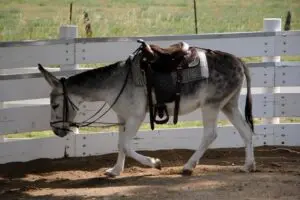

I ask Wrangler to “Whoa,” reward him for his stellar performance and ask him to stand four-square with equal weight over all four feet in preparation for mounting. I do not want to throw him off balance as I pull my weight into the saddle. Most equines will move if they feel a loss of balance. I politely mount and settle my seat easily in the saddle. I do not rudely plop myself down on his back.


As soon as I was mounted, I balanced myself in the saddle and offered rewards for standing still from both sides. My first move while mounted was the rein back. This would get his attention off bolting and put his mind on a task he can easily do. He is then rewarded again and happy with his accomplishment.


We walked for two rotations tracking to the left and then did an “S” turn through the middle of the Round Pen to change directions. I paid special attention while bending his body through the “S” turn to keep Wrangler’s body erect. I encouraged him to bend through his rib cage to make the turn smooth, forward and fluid.


We did two more rotations at the walk, then I asked for a balanced and correctly executed reverse. It is important to pay attention to the minute details while working slowly. This will promote accuracy later when you speed things up.


I walked Wrangler into a smooth and balanced halt. I made sure my own body was over the center of balance and that my hands and legs were even on both sides. I waited quietly for a few second to allow him to settle.


Then I asked Wrangler for a rein back with a pull/release action on both reins, but added a little more alternate pressure from one side to the other in sync with the front legs that were coming backwards. Wrangler did very well for his first riding session, so I thought it best to quit while we were ahead. It is easier for your donkey to learn when you keep lessons short and productive. Drilling for hours never really works…they just get tired and can’t really listen or perform well.


Although Chasity waits calmly while she is tied and Wrangler is working, he has to play with the artificial flowers in the planter when it is his turn to be tied. Next time, I will remove the temptation of the flowers! After Chasity finished her workout, we all made our way back to the work station. It was another successful and enjoyable training session for all of us!



WRANGLER’S DONKEY DIARY: Wrangler’s First Ride: 9-15-20
Wrangler has now completed his preparation for efficiently carrying a rider while staying in good equine posture with adequate core strength. Doing these kinds of logical and sequential exercises in a consistent manner makes all the difference in an equine’s physical development and mental attitude. Groundwork needn’t be boring for either you or your donkey. Doing these exercises the same way, every time, creates an unbreakable bond and deep understanding of what is expected between you. Before mounting your donkey in the Round Pen, there is one more interim step that needs to be done to keep your donkey standing still and his attention on you as you mount him. In the grooming area, I will mount the donkey and have him take oats from both sides of his body as we stand there. Then we will go to the Round Pen, do the preparatory lunging he has done before and mount in the same fashion. This will set up your donkey for success!


By now, your donkey should know his verbal commands and will not be compelled to just take off at the trot. He will walk leisurely along the perimeter of the Round Pen until you ask for the trot. He will remain in good posture and keep the “Elbow Pull” loose throughout his workout. He will have a rounded topline and overall balance that can easily support the added weight of a rider. Wrangler is doing beautifully!


After five rotations at walk and five rotations at trot, I ask Wrangler to slow to a walk. I then turn away from him in the opposite direction he is traveling and step in front of him to encourage him to reverse.


Then I send him to the rail for five more rotations at walk and then five at the trot. Wrangler is relaxed and moving freely forward. He is obviously strong in his balance and ready to be ridden.


I ask Wrangler to “Whoa,” reward him for his stellar performance and ask him to stand four-square with equal weight over all four feet in preparation for mounting. I do not want to throw him off balance as I pull my weight into the saddle. Most equines will move if they feel a loss of balance. I politely mount and settle my seat easily in the saddle. I do not rudely plop myself down on his back.
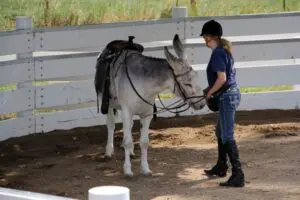
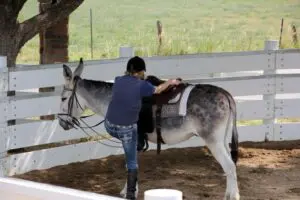
As soon as I was mounted, I balanced myself in the saddle and offered rewards for standing still from both sides. My first move while mounted was the rein back. This would get his attention off bolting and put his mind on a task he can easily do. He is then rewarded again and happy with his accomplishment.


We walked for two rotations tracking to the left and then did an “S” turn through the middle of the Round Pen to change directions. I paid special attention while bending his body through the “S” turn to keep Wrangler’s body erect. I encouraged him to bend through his rib cage to make the turn smooth, forward and fluid.


We did two more rotations at the walk, then I asked for a balanced and correctly executed reverse. It is important to pay attention to the minute details while working slowly. This will promote accuracy later when you speed things up.


I walked Wrangler into a smooth and balanced halt. I made sure my own body was over the center of balance and that my hands and legs were even on both sides. I waited quietly for a few second to allow him to settle.


Then I asked Wrangler for a rein back with a pull/release action on both reins, but added a little more alternate pressure from one side to the other in sync with the front legs that were coming backwards. Wrangler did very well for his first riding session, so I thought it best to quit while we were ahead. It is easier for your donkey to learn when you keep lessons short and productive. Drilling for hours never really works…they just get tired and can’t really listen or perform well.


Although Chasity waits calmly while she is tied and Wrangler is working, he has to play with the artificial flowers in the planter when it is his turn to be tied. Next time, I will remove the temptation of the flowers! After Chasity finished her workout, we all made our way back to the work station. It was another successful and enjoyable training session for all of us!



CHASITY’S CHALLENGES: Chasity’s First Ride: 9-15-20
Chasity has come a long way since the end of March. She has worked hard and is now enjoying true strength in a balanced and correct equine posture. Her health has greatly improved as has her mental attitude. She is happy to be working with her companion Wrangler and they both enjoy being able to share their lessons. Sometimes they are walked together to the Round Pen and sometimes they are taken separately. This promotes independence while preserving their friendships with each other. I do not believe in deliberately separating my equines from their equine friends as that will only create anxiety. I want them to know that I am also a friend that they would like to spend time with or without their other companions. Sometimes they are worked alone and sometimes they are worked together. Tying one outside the Round Pen while working the other teaches them to stand quietly while tied with purposeful patience. I leave nothing to chance, so I break everything down into doable steps to promote success. Chasity is mounted in the work station first and rewarded with crimped oats from her back. This routine will keep her attention when we finally go to the Round Pen as she is mounted.
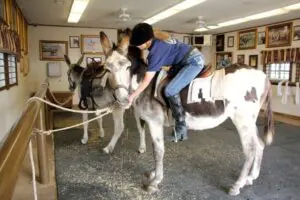

Chasity executes the gate perfectly, stands quietly to have her “Elbow Pull” adjusted and is then sent on the rail to lunge in preparation for mounting. She is now keeping her “Elbow Pull” loose at all times. Her balance and good posture is exceptional now considering her imperfect conformational restrictions.


I slow Chasity to the walk before asking her to execute a nice balanced reverse and she complies easily. It is important in the beginning to keep things slow and accurate. Speed can come later with much better results.


Chasity will now walk on command and will not change her gait until she is asked. She fully understands the verbal commands. She has smooth, upward and downward transitions as she changes gaits. She promises to be a smooth ride!


I ask Chasity for a halt and offer her a reward for a job well done! She is patient and stands quietly as I mount.


As I did in the work station, I offer her a reward from both sides. When she has finished chewing her oats, I ask her for the rein back. I use an even squeeze/release on the reins with a bit more pressure on one side and then the other as each front leg comes back. Even one step is sufficient for now. Chasity will give more with each new lesson.


Chasity walks calmly forward and I sit quietly to allow her to balance my weight. She keeps her body erect and bends through her rib cage as she executes an “S” turn through the middle to change direction. It is important to execute these moves with the lightest pull from my little fingers on the reins to encourage Chasity to become ultra-light in the bridle.


Donkeys tend to “lean” on the bit, so doing this kind of work in the Round Pen is really important if you want your donkey to be light in the bridle and respond to the lightest pressure from your seat, fingers and legs.


Be prepared to spend a lot of time on this. It will enhance all your donkey’s responses to your cues. Chasity executes a nice reverse and maintains her ideal balance at the walk afterwards. This is not easy for her to do with her hips being higher than her shoulders, but I am very pleased with her progress. She will only get better!


Chasity does a perfect halt, but is a bit reluctant to rein back. This move is difficult for her, so I will just take my time and accept what she has to offer. I know she is always honest in her attempts. One step is good, so I call it quits and reward her efforts.


Wrangler is outside the Round Pen waiting patiently for his “Lady Love” to complete her lesson. Then we all head back to the work station after our enjoyable time together! More lessons will promote more learning and more refined performance! We all look forward to our time together!



WRANGLER’S DONKEY DIARY: Wrangler’s Runaway: 9-1-20
Wrangler has been a happy camper since we acquired Chasity. Before that, he was so rambunctious that there was no one else that could be in turnout with him and I had limited time to work with him. He and Chasity are the same size and the same age, so they do get along very well. I still have to make training judgments when working with them. He helped me to get Chasity moving freely in the Round Pen during her first lessons, but lately, he has been annoying her while lunging which does not allow her to relax in the “Elbow Pull” like she should. And, he doesn’t relax either because he is too busy showing off to her now! So, I had to modify my approach. I still take them out together and just tie one up while I am working the other. I find that this works very well. Wrangler is back to moving in a dignified manner!
I can say that showing off to her did have its benefits. It developed his agility and his eagerness to move more forward and into a canter. When working him alone, I did not have to tie his reins to the saddle to keep his head up as I did when I was working him with her, but I did leave them on the bridle and secured them around his neck in case I did need them. His trot was very nice this time, so I decided to actually give the command to “Canter” and Wrangler willingly complied!
As Wrangler passed Chasity, he did occasional do a little crow-hop to acknowledge her, but mostly he stayed in good balanced posture and exhibited core strength with a lot of agility and flexibility. I used to think I needed to tire my animals to make them behave, but I have since found that when I pay attention to their physical development as well as the tasks I want them to do they are much happier and willing to comply. I PREPARE them for performance and bad behaviors decrease exponentially because I make them FEEL good! Good behavior is ALWAYS rewarded!
Wrangler decided to spook at a small branch that was on the ground, so I picked it up and we played with it! Then we got Chasity after her turn at lunging and made our way to the dressage arena.
Although Wrangler does tend to get a bit distracted when I have Chasity along, he does stay in sync with my steps most of the time. This is important in order to have their full attention.
This is Wrangler’s first lunge line lesson in the open, so I began with the short line as I usually do, but when he circled around me, he got to the point where he was facing Chasity and bolted toward her!
Apparently, Wrangler did not want to jump the fence, so he headed for the opening in the fence and then ran around the dressage arena perimeter. I just let go of the lines and watched him as he ran. I stayed where I was and assessed his movement while he got his “jollies” out!
He got halfway around and decided he wanted to go back toward Chasity. I guess he is not a confident jumper because he slowed down and carefully WALKED over the fence…in good balance and then cantered in balance in her direction!
I blocked him from going to Chasity and he darted to the left and toward the other end of the dressage arena. I called his name and asked him to come back…and he did…at a full gallop!
He thought about running around me, but decided a reward was a much better idea! Chasity was impressed with his performance and so was HE! I was just happy that Wrangler had decided to go back to work!
So, we repeated the process and he did nicely tracking to the left and halted quietly upon command. I did not let the line out very far. We would add that step the next time. I rewarded his success!
We did, however, do the same thing in the opposite direction, and again, I did not press my luck and kept the line shortened and controlled. Next, Wrangler would get his ground driving lesson in the open arena…another first.
I employed my Ranch Manager, Chad, as an assistant to make certain that things did not get out of control. I wanted to set Wrangler up for success. He was just perfect through the Hourglass Pattern and over the ground rails in the middle of the pattern.
After tracking through the pattern in one direction with the halts and rein backs in their designated spots between the cones, then crossing the diagonal and completing it the same pattern in the other direction, Wrangler did a perfect halt and rein back, and was amply rewarded for his success! It was time to quit!

WRANGLER’S DONKEY DIARY: Ground Driving with Chasity: 7-7-20
Wrangler is really beginning to enjoy his time working with me and helping with Chasity’s training! I think he is also happy to have someone he can be with in turnout after three years of being by himself… although a gelding, he’s just too rambunctious to be turned out with any of the others! They definitely form groups and it is wise to pay attention to the groups they choose…mid-aged mules together, minis together, older equines together and donkey families together. Wrangler LOVES his new friend, Chasity! They both truly enjoy the workouts we do together!
Chasity follows Wrangler around like a puppy dog! She is also very enamored with HIM! After adjusting his “Elbow Pull,” Wrangler and I watch the bicycles going by on the road. I find that it is beneficial when they see something, if you just stop what you are doing and look at it, too. Then, there isn’t as much of a fuss.
Chasity watches as I ask Wrangler to flex at the poll with an offer of crimped oats. This reminds him about how to take the pressure off the “Elbow Pull” and keeps him relaxed. Then all three of us pose for a picture before getting to work! All my equines seem to know when it is “picture time” and they always perk their ears! They are all a bunch of “hams!”
“Well, are we going to do a proper reverse?” I ask Wrangler. He promptly turns into the fence and leads Chasity down the rail of the Round Pen at a walk.
Both donkeys are stepping well underneath their center of gravity and do five rotations at walk before I ask them to trot for five more rotations. Chasity is doing much better about submitting to the pressure of the “Elbow Pull” and is able to sustain her balanced posture and self-carriage for longer periods of time now.
Chasity doesn’t “lean” on the “Elbow Pull” nearly as much anymore. Both halt promptly upon command, they get rewarded, then proceed forward again and do a perfect reverse together.
Again, we do five rotations at walk and make sure they are in a regular rhythm, cadence and are submitting nicely to the “Elbow Pull” before I ask them to trot. Wrangler has really good balance and posture and is always happy to lead the way!
Now Wrangler is going to show Chasity what Ground Driving is all about. This will help them both to learn how to stay in good posture while rein cues are being given. The result will be an animal who is exceedingly light in the bridle when you finally ride them. Wrangler executes a very smooth change of direction with the “S” turn through the middle of the Round Pen. Chasity follows obediently behind her “boyfriend!”
We track left for a while in the same form, then do one more reverse and after one more rotation at the walk, we come to a halt. Then I ask Wrangler to execute a proper reinback which he does willingly with no resistance at all. I just make sure to pull and release with the corresponding line as he takes each step backwards. He is then PROMPTLY rewarded with his favorite crimped oats!
When you are consistent, polite, respectful, reward for good behaviors, make sure tack and equipment fits comfortably and always do things exactly the same way, your animal will come to know what to expect and there will be minimal resistant behaviors, if any, because they will know what to expect from you and will act accordingly. Your time together will always be fun for everyone!

WRANGLER’S DONKEY DIARY: First Turnout with Chasity: 6-10-20
We tore down the quarantine panels and made one big area for Wrangler’s and Chasity’s turnout. Today would be their first time together in an open area by themselves. Chasity spent two months in quarantine with a double fence between them, then two weeks with a single fence between them. For those two weeks, they were introduced to the round pen and lunged together with no problems. Wrangler has finally found his “LADY LOVE!” But, for the time being, Wrangler is more interested in this GREAT BIG NEW PEN! Chasity watches him with interest while he inspects every square inch of the area.
Wrangler suddenly bolts and runs with joy!!! Chasity goes to the corner and pretends she doesn’t notice his exuberance and obvious male flirtation!
Chasity then meanders over to talk with our miniature gelding horse, Mirage. Wrangler gallops over to flirt with our miniature mule, Francis, to make her jealous, but Chasity is not moved, so Wrangler goes after her to break up the tryst!
Chasity just moved down the fence line and Mirage followed her. Wrangler went after her and herded her to the other side of the pen where Chasity stopped and Wrangler patrolled the perimeter to keep her from returning to Mirage. Chasity is slightly incensed
Wrangler made an approach and Chasity promptly chastised him and sent him to his corner. Then she trotted down to her corner and they pretended not to notice each other!
Chasity walked back up to Wrangler to try to make up and he galloped off in a huff! She then decided to play hard-to-get and returned to her corner where he promptly approached her again…this time, much more cautiously!
After they had stood still for a while, I called Chasity and Wrangler over for a reward of crimped oats. They came obediently and stood politely next to each other to receive their “goodies!” They then watched me leave with acute interest… “Well, aren’t you going to give us MORE?!!!”

WRANGLER’S DONKEY DIARY: SHARING THE EXPERIENCE: 6-10-20
Wrangler was introduced to our new donkey jennet, Chasity, with a double fence between them and has seen me working with her for two months now. After being alone in turnout for three years, he will finally have a turnout buddy once she is out of quarantine. This will happen in just a few days. However, I could sense that Wrangler was jealous of the time I was spending with Chasity, so I decided to surprise him! He obediently came to the stall door and waited patiently to be haltered, but it had been such a long time since he had seen the Tack Barn work station that he needed to PAUSE…


…and take a good look at the metal drainage grating before entering. He was rewarded at the hitch rail for being brave and was somewhat curious about what would be happening next.


Wrangler was so pleased when I walked through the door with his new love, Chasity! They both looked expectantly as I walked from the Tack Room with the familiar towel. I cleaned their eyes, ears and nostrils.


Wrangler showed Chasity that the “monster vac” was nothing to be afraid of. He stood quietly while I put on his Passier All Purpose English saddle. With the girth four inches back on the swell of his barrel, so as not to chafe the sensitive skin right behind his forearms, I adjusted his crupper to hold it firmly in place.


They both watched me intently as I returned to the Tack Room for the bridles. Wrangler politely lowered his head to make bridling much easier. I always return the favor by being VERY CAREFUL about pushing their ears through the headstall by protecting them with my hand as I slide the crown piece over them.



I took Wrangler to the Round Pen. Then I went back to the Tack Barn, got Chasity and tied her outside so she could watch him being lunged. I hoped this would help her to “get it” when it became her turn!


Wrangler was in pretty good shape when I got him three years ago. He’s always kept himself balanced and in good shape, so he was able to go straight to lunging for core strength in his “Elbow Pull.” He only had two lessons two years ago, but his good posture and core strength has endured. The “Elbow Pull” remained loose throughout his entire workout in the Round Pen.


He planted his pivot foot, easily executed his reverse and continued the same way in the other direction. I was so proud of him! Wrangler reminds me a lot of my super champion jack from 1980-2014, Little Jack Horner! What a classy guy!


Since Wrangler was doing so well, I decided to go ahead and let him try lunging with Chasity. They had not yet been in the same pen together, but I trusted he would behave himself and he surely did! He encouraged her to go forward and then did his reverse promptly on command. She took a bit more persuading to reverse, but he patiently walked until she caught up with him.


With Wrangler in the lead, they did five more rotations and Wrangler never swayed from his good equine posture. When we were done, I tied Chasity to a post in the Round Pen and returned to the Tack Barn with Wrangler. He was so happy to finally be able to spend some time with me and to share his experience with Chasity!



